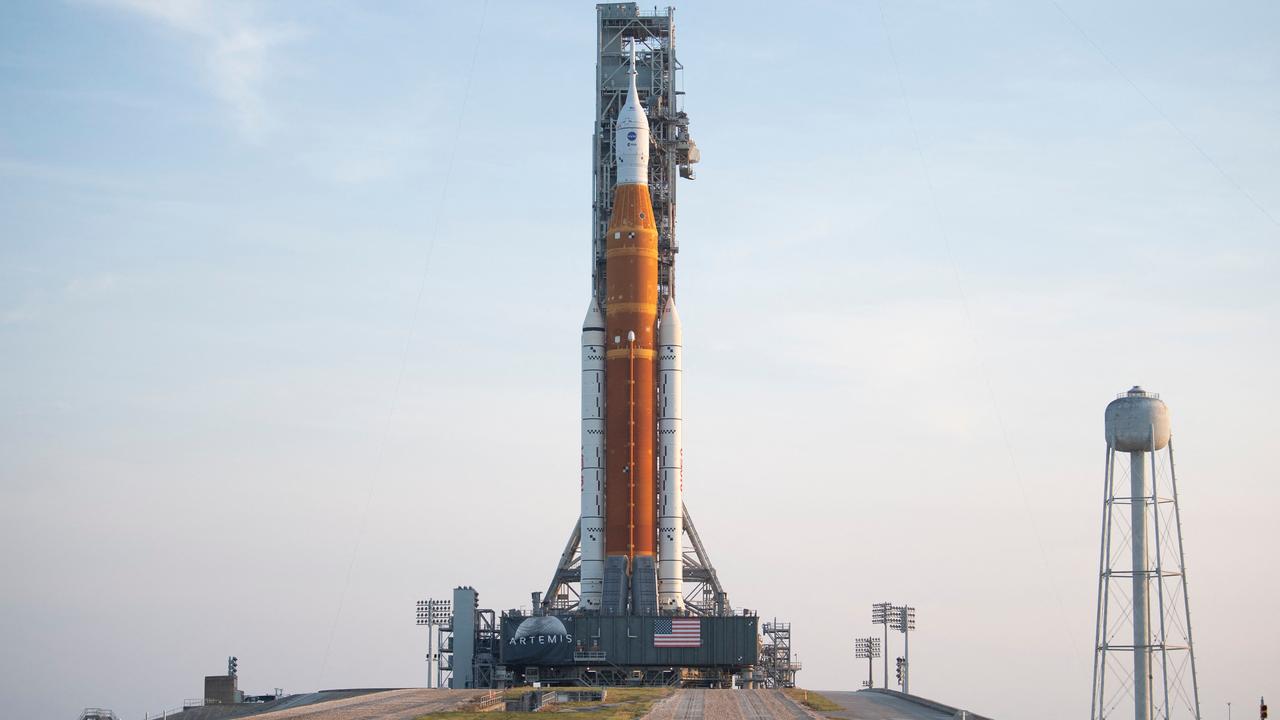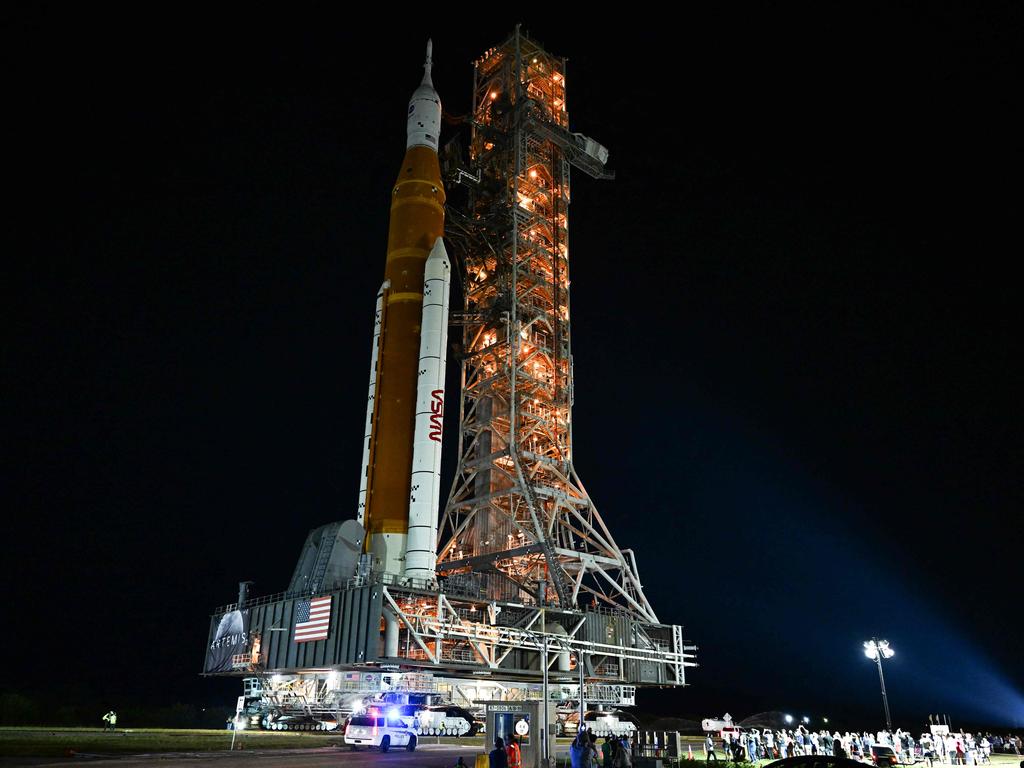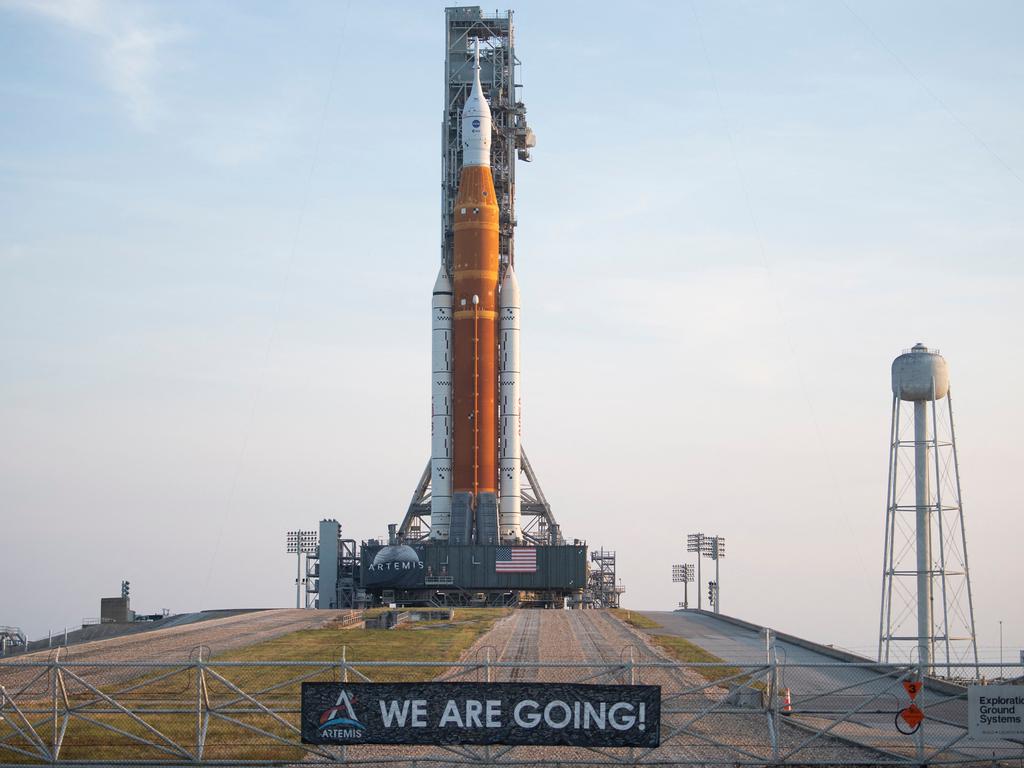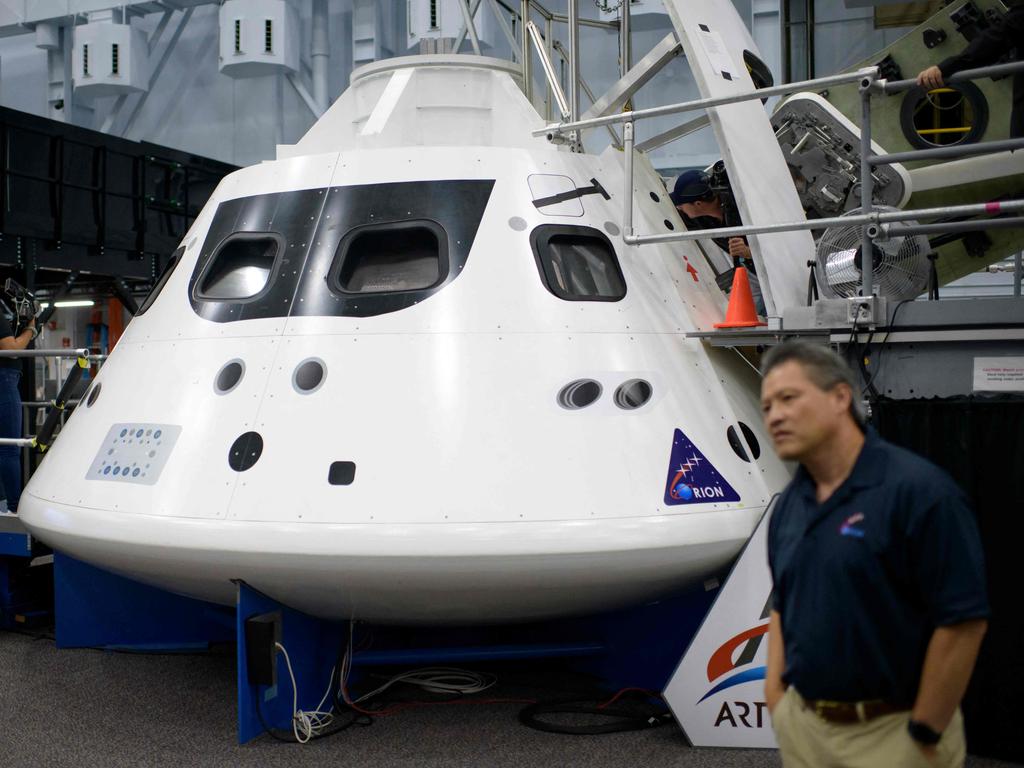NASA’s Artemis I bound for moon almost 50 years after last Apollo mission
Fuel leaks stopped the Artemis I mission lifting off as planned overnight. As engineers work to fix the problem, let’s learn more about the mission and why NASA is returning to the moon after almost 50 years

READING LEVEL: GREEN
NASA’s first mission to the moon in almost 50 years has been delayed because of fuel leaks discovered during final preparations for launch.
The Artemis I mission was scheduled to blast off overnight but the uncrewed voyage was postponed as engineers tried to discover what was causing the leak of the rocket’s highly explosive hydrogen fuel.
The launch at the Kennedy Space Centre in Florida in the US will now not take place until at least September 2.
While NASA works to get the rocket ready, let’s take a look at the Artemis mission and what it’s all about.
What is the Artemis program?
Named after the Greek goddess of the hunt, Artemis is the US’s primary space exploration program for the rest of this decade and into the 2030s.
Artemis will help pave the way for a long-term lunar presence – both on the surface and in orbit – and create a stepping stone for onward missions to Mars. It will also put the first woman on the moon by 2025, as well as more ethnically diverse* crews.
Four Artemis missions are planned between now and 2027, with other uncrewed support flights in between to deliver hardware* to support future missions.

Why are we going back to the moon, and why has it taken 50 years?
NASA carried out six successful moonwalks involving 12 astronauts between Apollo 11 in July 1969 and Apollo 17 in December 1972. (Four of those astronauts are still living, including the second man to walk the lunar surface, Buzz Aldrin.)
Since the 1970s, NASA’s priorities have shifted to programs such as the Space Shuttle, the International Space Station and the Voyager missions.
But the discovery of “signatures”* of liquid water on the moon in 2020 excited space scientists and reignited* lunar interest, said Royal Institution of Australia astronomer* and lead scientist Professor Alan Duffy.
He said the presence of water “changes the economics of space travel”.
“It means we have the chance to go back to the moon, not just to walk, but to work,” Prof Duffy said.
NASA has already identified 13 locations near the moon’s south pole as suitable sites for future Artemis landings – and all to find water.

“Until very recently we thought the moon was a desert, beyond anything we’ve experienced on Earth … just so dry and devoid of water,” Prof Duffy said.
“Now we want to go and see just how much there is. Water can be used by astronauts directly, or it can be split into hydrogen* and oxygen*, which is literally rocket fuel.”
China also has its eye on the moon’s south pole, with plans to put its own astronauts on the lunar surface in the early 2030s – a factor that may have sped up NASA’s efforts.
Prof Duffy said that if lunar water was found it could turn the moon into a “resupply station as well as a refuelling station” – opening up the possibilities for exploration to Mars and beyond.

How much does the Artemis program cost?
Nothing in space comes cheap: $US40 billion (A$57.8 billion) has been spent already, and by the end of 2025 this figure will be $US93 billion (A$134.4 billion).
While the expense might seem jaw-dropping, NASA was trying to keep costs down, Prof Duffy said.
“NASA’s not trying to do it all itself,” he said. “It’s actually got lots of commercial contracts, small and medium enterprises*, even start-ups have contracts with NASA to support them in various ways for the return to the moon.
“They’re trying to build an entire industrial ecosystem*, the industrialisation* of orbit, of space, but in particular the moon – and that’s a huge difference.”

What spacecraft are used in the Artemis program?
The first three Artemis missions will combine an Orion space capsule capable of fitting six crew, sitting atop a Space Launch System (SLS) rocket.
The hydrogen-fuelled SLS is the most powerful rocket NASA has ever built, capable of producing almost 4 million kilograms of thrust during launch.
The Orion also contains its own propulsion* system, enabling it to power on to the moon and back.
Between Artemis II and III, a SpaceX rocket will launch, delivering a Human Landing System (HLS) spaceship into lunar orbit. The HLS will conduct an uncrewed lunar landing and return to orbit to test its capabilities. It will later be used by two crew members of Artemis III to descend to the lunar surface.
Artemis IV, in 2026, will carry the first habitation* modules for Gateway, a space station which will be set in orbit around the moon and which will become NASA’s outpost for future missions to the moon and Mars. Gateway will also act as the “garage” for the HLS.

What are the first missions of the Artemis program?
This first flight has several objectives*, the most important being to test the SLS and Orion as spacecraft that can safely send crew to the moon and back again.
The craft will also itself launch 10 very small satellites which will gather data on the moon, a near-Earth asteroid*, and space itself.
All going well, NASA will launch the second Artemis mission in May 2024, with four crew blasting off on a 10-day journey to the moon and back, but taking a different trajectory* to Artemis I.
Then in 2025, Artemis III – including at least one female astronaut – will include a visit to the lunar surface as part of a 30-day mission.

How long will it take Artemis to reach the moon?
The Orion will almost do a full orbit of Earth as it escapes the atmosphere, before it sets out on its six-week journey around the moon and back home.
About nine hours after lift-off, we should start to see the first images of our planet from Orion.
The ship will travel some two million kilometres in total, and for about six days it will orbit the moon, about 100km above its surface.
It will then fire its rockets and slingshot back to Earth – coming in “faster and hotter” than any spacecraft we’ve seen before, NASA said.
When Orion hits the atmosphere it’s expected to be travelling at 11km per second, producing temperatures of approximately 2760C.

Who are the astronauts on the Artemis mission?
While Artemis I is uncrewed, three advanced mannequins* (dubbed “moonekins”) fitted with sensory equipment will be used to measure levels of solar radiation*, G forces and the like. Two of the mannequins will be female and one male. An untethered* Snoopy doll in the cabin will also help determine when weightlessness occurs.
For future Artemis missions, NASA has so far selected 18 astronauts (nine men and nine women) as their initial pool of candidates. They range in age from 34 to 57, and include veterans of Space Shuttle and International Space Station missions. All incredibly accomplished individuals, two of the women have also played rugby competitively, and several are musicians. All are American citizens, though one was born in Taiwan, and another holds dual US-Swedish citizenship.

What is the significance of NASA putting a woman on the moon?
Take a look at any group photo of Apollo astronauts from the 1960s – they’re all white men. And there was no good reason for this, said Prof Duffy, “other than the biases* of the time”.
“Technology isn’t the only thing that has changed since the Apollo era,” said Dr Rebecca Allen from the Centre for Astrophysics and Supercomputing at Swinburne University of Technology.
“It’s no secret that the space sector has lacked diversity and inclusion*.”
Dr Allen said the Artemis program “will provide visibility and inspiration as the next space workforce emerges”.
Diverse crews are expected to be the norm for future space missions, particularly longer journeys to Mars, but there are a few things NASA has to learn about women in space.
Two female mannequins on Artemis I will provide an insight into the effect of prolonged solar radiation on the female body, as it is thought breast and ovarian tissue are more susceptible* to cancer through radiation.

Will Australia play a role in the Artemis program?
The Canberra Deep Space Communication Complex at Tidbinbilla is one of three facilities around the world forming NASA’s deep space network, which will be used to track communications from all crewed and uncrewed Artemis missions.
“As the Earth turns, it means that the US tracking station Goldstone (in California’s Mojave Desert) can no longer see the spacecraft, so it hands over to Spain or it hands over to Tidbinbilla,” said Prof Duffy. “We will play the same role in Project Artemis that we did with Project Apollo.”

But that’s not the totality of Australia’s involvement. We’re also one of 21 countries to have signed the Artemis Accord, a US-led agreement providing a framework for how exploration and mining operations on the moon will be managed.
Prof Dufy said Aussie scientists were also working on a lunar rover for deployment* as early as 2026.
“It will essentially be an extractor, a rover that can dig the soil of the moon … to see if we can extract metals, particularly iron for construction on the moon, but also water,” he said.
GLOSSARY
- ethnic diversity: recognising and including different races of people
- hardware: physical tools, machine components, equipment
- signatures: molecular properties, elements, traces
- reignite: restart, renew, recommence
- astronomer: scientist who studies the stars, planets, and other natural objects in space
- hydrogen: chemical element that is the lightest gas, has no colour, taste, or smell
- oxygen: a gas with no smell or colour, needed in Earth’s air for animals and plants to survive
- enterprises: businesses, companies, commercial operations
- ecosystem: community of organisms and their physical environment interacting together
- industrialisation: process of developing industries in a particular place
- propulsion: force that pushes something forward
- habitation: designed for living in, shelter, the state of living somewhere
- objectives: what is planned to be done or achieved
- asteroid: rocky objects that orbit the sun that are much smaller than planets
- trajectory: curved path of something travelling through space
- mannequin: a large, life-size model of a human being
- radiation: energy from a source that travels through space at the speed of light
- untethered: loose, unrestrained, released
- biases: tendency to prefer and unfairly favour a person, thing or group of people
- inclusion: having many different types of people and treating them fairly and equally
- susceptible: easily influenced or likely to be hurt or harmed by something
- deployment: act of putting something into effective use
EXTRA READING
Buzz Aldrin’s jacket sold for sky-high price
Surprise! Seeds grow in moon soil
Australia’s historic first moon mission
QUICK QUIZ
- Who or what is the Artemis program named for?
- Artemis I is uncrewed but how many male and how many female astronauts have so far been selected for future program missions?
- What will Artemis IV be carrying when that mission launces in 2026?
- When Orion hits Earth’s atmosphere on re-entry, it will be travelling at what speed and temperature?
- What role will Australia play in the Artemis mission?
LISTEN TO THIS STORY
CLASSROOM ACTIVITIES
1. Timeline of future space travel
After reading the Kids News article about all NASA’s future space missions, construct a timeline containing the main details of each upcoming mission. Make your timeline easy to read and decipher and highlight Australia’s involvement in each.
Present your timeline on an A4 piece of paper.
Time: allow 25 minutes to complete this activity
Curriculum Links: English; Science; Critical and Creative Thinking
2. Extension
“It’s no secret that the space sector has lacked diversity and inclusion”.
How does NASA plan to change this in the coming decade?
What should we do to encourage a more diverse and inclusive demographic to become a part of future space projects?
Time: allow 15 minutes to complete this activity
Curriculum Links: English; Science; Personal and Social; Critical and Creative Thinking
VCOP ACTIVITY
To sum it up
After reading the article, use your comprehension skills to summarise in a maximum of three sentences what the article is about.
Think about:
- What is the main topic or idea?
- What is an important or interesting fact?
- Who was involved (people or places)?
Use your VCOP skills to re-read your summary to make sure it is clear, specific and well punctuated.

